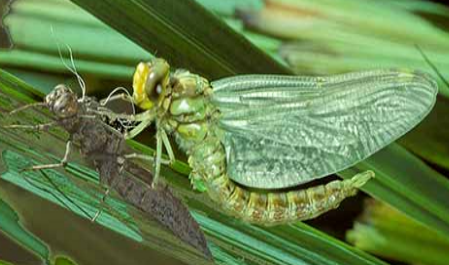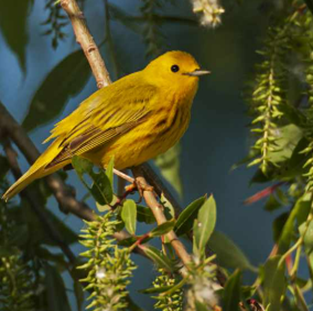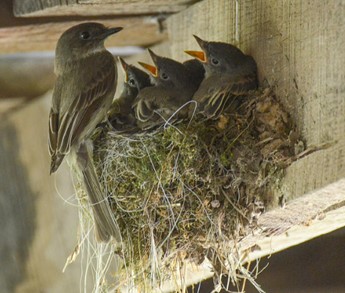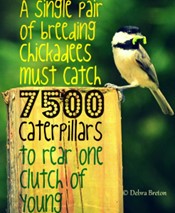“Oh, deer!” The September 7th Lake & Wildlife Partners Program was about Bent Tree’s deer herd. Following that theme, September’s Wildlife Wednesday posts will be about white-tailed deer (Odocoileus virginianus). We hope you all learn something new and interesting!
What do deer eat?
All your landscaped plants, right? 😊 Well, of course! Landscape plants, especially fresh from the nursery, are young and tender, well-watered and well fertilized! And once the whole herd samples it … Very frustrating for us and the deer, since that is not really a sustainable food source.
Deer are ruminants but they are not cows. Their 1st stomach chamber (called the rumen) is small and cannot digest large amounts of grasses. Their pointed nose and long tongue are adapted to selecting specific plant parts. The mainstay is browse, the leaves and twigs of woody plants like young trees and shrubs. Even when leaves drop the stems and twigs are fairly nutritious. Their favorite is forbs, which are non-woody flowering plants. Though favored, they are not available year-round. Acorns, nuts and fruits (mast) are high energy sources, and mushrooms as suppliers of phosphorous for antler growth, round out the diet. Only very early growth grass is digestible enough for deer. That is why they do not eat the stilt grass; they would starve to death with a stomach full of such low-quality forage.
Deer are adapted to survive winter on their fat stores and on the dormant buds and twigs of woody plants. It takes 2-3 weeks for deer to develop the digestive enzymes necessary for new foods. Introducing new foods, especially in winter, is especially harmful. * Don’t feed the wildlife *

Are white-tailed deer dangerous?
White tailed deer are generally not dangerous to humans. Given the choice of fight or flight, they are most likely to choose flight. The exceptions to this can be 1. mothers protecting their young, 2. males during rut (mating season), or 3. injured or diseased animals.
Several times in the late spring there was a doe at Sallie Doss that would impede walkers progress along the trail and was especially hostile to dogs. She apparently had a young fawn in the area and was being very protective mom. In the fall, males vying for dominance and the attention of a female can be aggressive. Injured animals can be very unpredictable, and their antlers and hooves are sharp. (Info on injured and orphaned animals)
Signs of aggression in a deer are a stiff heavy walk with stomping, a tilted antlers or dropping ears, and a flat or slightly raised head. Blowing and snorting are sounds of alarm from a deer. If you meet an aggressive deer give them a wide berth. Avoid eye contact and slowly back away.

When and where do deer sleep?
Whitetails are crepuscular animals, meaning they move mostly around dawn and dusk. They do most of their bedding during the brightest daylight hours and periodically throughout the night.
Bedding locations are determined by shading, slope and aspect of the ground, wind speed and direction, and proximity to sources of food. Unless in a bachelor group or tending a doe, bucks typically bed down alone. Does almost always bed in family groups, and each one beds down facing in different directions to watch for danger.
Deer remain alert while they sleep and their head position changes constantly. Sleep is necessary for health and survival, but as a prey species so is the ability to be somewhat alert while sleeping. A typical sleeping bout for a deer includes 30 seconds to a few minutes of dozing, followed by a brief alert period, and then more dozing followed by an alert period. This cycle often lasts for only 30 minutes followed by standing and stretching.
Mature bucks will typically bed alone with a thick stand of trees at their backs.

Deer in the Winter
White-tailed deer are tannish to reddish brown in summer. They shed their summer coat in the late fall and grow a grayish winter coat. Each individual hair of the winter coat is hollow and acts as an insulator trapping body heat. A short undercoat provides additional insulation and water protection.
It is important to put on extra weight in the fall in preparation for the winter. They will shelter in thickets and on south facing slopes for more warmth. They will bed for longer period to conserve energy. Minimizing movement is important for deer and many animals to save crucial energy stores that are needed until the spring green up. Being chased by dogs during the winter can waste energy that the deer do not have to spare. Keeping dogs in fences and on leashes helps our local wildlife population survive.
Though it may seem beneficial, it is especially important to not feed them during the winter as deer are adapted to less food at this time and will not be able to digest it properly. Felling small trees so that the woody twigs and buds are available to the deer is the best way to ensure continued appropriate nutrition during the lean times of late February and early March.
In-between the reddish summer coat and the thicket grayer winter coat

CREATURES IN BENT TREE’S WATERSHED
A watershed is an area of land whose streams drain into a single body of water. The Bent Tree watershed includes all Bent Tree as well as surrounding mountains that drain into Lake Tamarack. Healthy watersheds provide great benefits to the people and wildlife that live there. Current Wildlife Wednesday posts highlight some critters with tight ties to the streams in our watershed.
RACCOONS
Raccoons are in the Procyonidae family (procyon, meaning to wash). Raccoons are famous for their tendency to “wash” their food, but they’re not washing anything at all! Raccoons have the most sensitive sense of touch of any animal known. Over two thirds of the sensory processing power of their brain is dedicated to its sense of touch, while the critter’s tiny hands have ten times the number of nerve endings as a human hand.
These very sensitive hands develop a thin protective barrier over time— sort of like a callous— but the layer is softened by water. When a raccoon dips its hands into water, it can feel with perfect acuity. A raccoon will explore its food, memorizing and savoring its texture to learn about it and to be better able to identify and search for it in the future. In the wild they only do it occasionally, but are often seen with their hands dipped in water as they search for crayfish, snails, fish, and worms. The streams of our watershed are vital to all the creatures that call Bent Tree home.
A funny video of raccoons ‘washing’.

Raccoons must drink every day and open fresh water sources are critical.
“EPT” MACROINVERTEBRATES
The Bent Tree Stream Keepers monitor our streams, including biological assessments that directly measure the health of the organisms living in the streams. In wadable streams, benthic macroinvertebrate communities are assessed quarterly. Benthic macroinvertebrates are valuable bioindicators since they cannot escape the effects of pollution and are a “canary in a coalmine” for water pollution.
Mayflies (Ephemeroptera), stoneflies (Plecoptera) and caddisflies (Trichoptera) are the most sensitive to changes in water quality. A large percentage of “EPT” taxa in a stream indicates clean water and good aquatic habitat. They clean the streams by consuming leaves and woody debris. These small and often forgotten aquatic organisms are an important part of the stream food web.
Human development can negatively impact freshwater ecosystems if fertilizers, pesticides and loose soil find their way into streams. Do not improperly dispose of potentially toxic substances in yards and follow AC guidelines for construction projects that require silt fencing.

Mayfly nymphs live up to a year in the water, feeding on plant material. Photo by Steve Luell.

Adult mayflies do not feed and only live a day once leaving the water
DRAGONFLIES
Dragonflies are voracious predators that can capture prey in the air in a net-like scoop created with their legs. With a 97% hunting success rate they can eat hundreds of mosquitoes, flies and other insects every day. Masters of the air, some can fly 20 mph, fly up and down, forward and backwards!
Large eyes are so close together that the two eyes almost look like one. Their compound eyes have 30,000 individual lenses and almost a 360-degree range of vision. Interestingly, their eyes are constructed much like bifocal lenses, with the upper portion allowing them to view distant objects hundreds of feet away and the lower portion, objects close by.
Most of a dragonfly’s life is spent as a nymph in the water, taking up to two years to develop into an adult and molting up to 15 times in the process. When ready, they climb on a plant and shed their exoskeleton for the last time. Dragonflies are more numerous in high-quality water, so their abundance is an indicator of healthy aquatic ecosystems. Minimizing erosion to keep silt out of our streams protects the nymphs. Native vegetation is a great way to prevent erosion, and maintaining vegetation at the water’s edge is crucial.

Dragonfly emerging! In many cultures the dragonfly is a symbol of positive transformation and change. After spending their youth as nymphs in the water, they emerge from exoskeletons with full adult wings.
YELLOW WARBLERS
Yellow warblers are one of the colorful migratory songbirds that appear in North Georgia in April and again in September. Most pass through on their journey between more southern wintering grounds and more northern breeding grounds. They come in many colors, but their characteristic thin pointed bills are especially adapted to a diet of insects.
Not frequently found at feeders, yellow warblers feed in meadows and woodlands where insects are abundant. They are especially attracted to areas along stream corridors where they nest in willow and alder trees. Aquatic insects such as mayflies are part of their diet.
Spraying for mosquitos is not only ineffective at controlling them, but it also kills most other insects. This hurts songbirds like the yellow warbler. Mosquito control efforts are most effective at the larval stage by minimizing stagnant water and the use of easy to make ‘mosquito buckets’.

Yellow warblers like to feed in native black willow trees where insects are abundant.
SNAKES
The next Wildlife Wednesday series will be about snakes. Let’s learn something about these creatures which are so often feared. Know that you are much more likely to be hurt by a dog than by a snake. Snakes help control the tick and rodent populations and snake venom has unique medicinal uses in cancer treatments. Strictly carnivores, snakes are both predators and prey which helps to maintain balance in a diverse ecosystem. Each article in this series will focus on a species or category of snakes, tune in!
The Kingsnake
Let’s start with a relatively distinctive and beloved (as snakes go) species, the Eastern Kingsnake. The Eastern Kingsnake is shiny black with yellow to white markings that differ based on region. In the north Georgia forests these markings are typically thin yellow bands.
Strong constrictors, kingsnakes average 3 feet long but can grow up to 7 feet. The kingsnake is most active in daytime, especially the morning. Kingsnakes use woodpiles and downed logs for cover and to lay eggs in moist shaded places. With anywhere from 3 to 20 in a nest, the leathery eggs are mostly white and about the size of jellybeans. Baby kingsnakes hatch in late August and look just like small versions of their parents.
There are several reasons to feel good about having a kingsnake on your property. Immune to venom, kingsnakes eat copperheads and rattlesnakes (hence the name
kingsnake). They also provide effective rodent control. Besides all that, it is illegal to capture, harass, or kill any non-venomous snake in Georgia, so you might as well learn to appreciate their benefits!

The head of the Eastern kingsnake is short and stout.
Queen snakes and other aquatic snakes
Regina septemvittata is the Latin name for Queen Snake, and ‘regina’ in latin means Queen. It is not known how this common, unassuming aquatic snake got its royal name. Gray, brown, or olive green, the yellow stripe on their side is the easiest way to identify them. Growing no more than 2 feet, queen snakes are often seen in or around streams or lakes where their favorite food, crayfish, live. Queen snakes are among the 30% of snakes that give live birth (the other 70% lay eggs).
Two other snakes that are found near and in water are the banded water snake and the northern water snake. These harmless water snakes can, unfortunately, be confused with the copperhead. Venomous copperheads are responsible for more bites than any other snake, so it is not helpful to the water snakes to resemble the infamous copperhead. There are a few features that will differentiate them. The copperhead’s pattern and band is narrowest on top and looks more like an hourglass while the water snakes are either wider at the top or the same width all the way around. The head of a water snake is the same size and shape of its body with no obvious neck, while the copperhead has a triangular head clearly different then it’s body shape. True to their name, water snakes swim with only their head above water while a copperheads entire body will skim the surface of the water when swimming.
If you have any uncertainty at all, avoidance is best. The huge majority of snake bites occur when a person or pet is messing with a snake. Giving them a wide berth is always the best approach.
 The yellow stripe is a defining characteristic of the small grey queen snake.
Garden Snakes
The yellow stripe is a defining characteristic of the small grey queen snake.
Garden Snakes
Generally less than 2 feet long, there are many types of snakes in your yard that you might encounter when gardening. Some of them live under the mulch or burrow in the soil of the flower beds. Active gardeners may see ringneck, worm, red-bellied, brown, earth, and crowned snakes. None of these species are much bigger than a large earthworm and do not bite. Admirers of these petite snakes sometimes refer to them as ‘snakelings’.
Sometimes mistakenly called a “garden snake,” the very common garter snakes get their name from the long, yellow stripes down the length of their green, brown, or black bodies that is reminiscent of a garter belt. Like many snakes, its defense is to squirt a foul, greasy fluid called musk from it’s tail. Must causes some predators to choose a different meal.
Green (or grass) snakes are perfectly suited to living amongst green plants and can go undetected in a flower bed or shrubbery. Green snakes will often bob their head in order to mimic vegetation blowing in the wind.
Though small, these snakes are strict carnivores. They will eat anything they can overpower. This includes snails, earthworms, frogs, leeches, small fish, centipedes, grasshoppers, and other insects.

Earth snake often lives in the mulch and soil in flower gardens.
RAT SNAKES
Rat snakes get their name from their favorite prey. The many different species that are all called ‘rat snakes’ come in a variety of patterns and colors. A common rat snake here in Bent Tree is the Eastern, or black rat snake. These large constrictors have a characteristic white chin and belly. Good climbers, these snakes also feed on squirrels, birds, and smaller reptiles found in trees.
The corn snake is another. Also known as red rat snakes, they are a slender species of snake known for their orange coloration. Corn snakes can also be yellow or gray, with red or brown blotches on the back. On the belly is a checkered pattern that resembles Indian corn. Like some water snakes, at first glance corn snakes can be mistaken for the venomous copperhead.
Rat snakes are relatively slow moving and will most often “freeze” when first encountering danger. This is why so many are killed on roadways. When “freezing” on the ground they will often take on a rippled posture, looking like a large, unironed ribbon. Take the time to check it out if you see this in the road and don’t run over it!

Notice how the bands on this corn snake are
widest on the top. Bands on the copperhead are
most narrow on the top.
------------------------------------------------------------------------------------------------------------------------------------------------------------------------
Bent Tree Birding
Bent Tree offers wonderful birding opportunities to the experienced or the novice birder. Song birds are especially easy to identify, with great smart phone apps that allow identification by sound. The woodlands and wild areas of Bent Tree provides habitat for many songbirds to live and rear their young. Good habitat includes resources to survive, mainly food and water, shelter, and space.
June 12 2024
The
American Goldfinch males develop bright yellow feathers in the spring preparing for the summer courtship and breeding season. While most songbirds eat insects and caterpillars, goldfinches’ diet is mainly seeds. They nest late in the year, coinciding with native thistle blooms which are used for nesting materials. Thistles belong to the sunflower family and may have sharp spines, but they also have lovely pink blooms and produce fluffy down softer than a blanket for goldfinches to use in their nests.
Those sharp spines are why some people don’t want them in their yards, because, well, ouch! But knowing how important the thistle down and seeds are to goldfinches should make us think twice about removing them. Another great plant to support the American Goldfinch is Golden Ragwort (packera aurea). It is readily available in the nursery trade and is highly deer resistant. Pick one up and give it a try in your yard or on your deck. Be sure allow plenty of flower heads to go to seed for the goldfinches.
 Goldfinch nesting and native thistle blooms happen at the same time. The timing of biological events in animals and plants is known as phenology.
June 19 2024
Goldfinch nesting and native thistle blooms happen at the same time. The timing of biological events in animals and plants is known as phenology.
June 19 2024
A common Bent Tree bird that has benefitted from manmade structures is the Eastern Phoebe. Their sturdy nests are about 5 inches across and 4 inches tall and are often built on tops of downspouts or under porch eves that are protected from the elements. Phoebes typically raise 2 broods a year and, with a bit of freshening up, will often reuse nests year after year.
Phoebes are in North Georgia year-round and frequent wooded areas where insects are abundant. You will recognize this plump bird from the up and down twitching of its tail when it perches and it’s raspy persistent ‘fee-bee’ song. Grayish brown on top and lighter colored below, it has a short thin bill used for catching flying insects. Males and females share parenting duties, catching an average of 1.2 insects per minute during chick feeding time.
Phoebe populations are steady due to their ability to live alongside people. Two specific human related dangers can be a problem for them - outdoor cats and pesticides. Keeping cats indoors and not using pesticides in your yard will allow Phoebes to thrive.

There are between 2 and 6 in a clutch, and when close to fledging it gets to be a very tight fit in the nest.
June 26 2024
Birds in the Paridae family are frequent visitors to bird feeders and therefore relatively well known. With their round heads, plumb bodies, and energetic behavior, these small birds are universally considered ‘cute’. Bent Tree’s most common examples are
Carolina Chickadees and Tufted Titmouse. You might think they are gathering all those seeds from the bird feeder for their young, but that is not the case. Adult birds benefit from seeds especially in the winter, but almost all fledglings require insects and caterpillars to get enough protein.
Because native trees and shrubs evolved with local wildlife, they have more insects and nutritious berries and fruits than non-native varieties. Research reveals that a native oak tree supports more than 550 kinds of butterflies and moths, whereas a non-native crepe myrtle supports fewer than five species.
To support the chickadees and titmouse families in your yard, check out some great native
“keystone’ plants that you can grow on your deck or porch. If you have a sunny area, allowing a section to be ‘wild’ where more vegetation can grow. Save yourself time and money with less mulching, less mowing and less weed eating. The birds will thank you!
 WOW!!
WOW!!